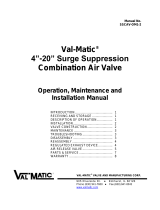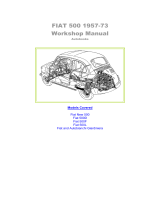Page is loading ...

Manual No.
SSAVV-OM2-1
Val-Matic
®
1/2”-3” Surge Suppression
Air/Vacuum Valve
Operation, Maintenance and
Installation Manual
INTRODUCTION ........................................... 1
RECEIVING AND STORAGE ....................... 1
DESCRIPTION OF OPERATION .................. 1
INSTALLATION............................................. 2
VALVE CONSTRUCTION ............................. 2
MAINTENANCE ............................................ 3
TROUBLESHOOTING .................................. 3
DISASSEMBLY ............................................. 3
REASSEMBLY .............................................. 3
REGULATED EXHAUST DEVICE ................ 3
PARTS & SERVICE ...................................... 4
WARRANTY ................................................. 5
VAL-MATIC
®
VALVE AND MANUFACTURING CORP.
905 Riverside Dr. ● Elmhurst, IL 60126
Phone (630) 941-7600 ● Fax (630) 941-8042
www.valmatic.com

1
VAL-MATIC’S 1/2”-3” SURGE SUPPRESSION
AIR/VACUUM VALVE
INTRODUCTION
This manual will provide you with the information
to properly install and maintain the valve to
ensure a long service life. The Surge
Suppression Air/Vacuum Valve has been
designed with stainless steel trim to give years
of trouble free operation. The valve is typically
mounted on a pipeline at the high points or large
changes in grade.
The valve will exhaust large quantities of air in a
controlled manner during system start-up and
allow air to re-enter the line rapidly upon system
shut down or after a power failure. The valves
are needed to maintain pipeline efficiency while
providing protection from adverse pressure
condition. The Size, Maximum Working
Pressure, and Model No. are stamped on the
nameplate for reference.
NOTE: While Air/Vacuum Valves will exhaust
large quantities of air upon start-up, they will not
continuously release air during system
operation. For that function, Air Release Valves
are required.
Also, this valve is not intended for fluids
containing suspended solids such as
wastewater. For wastewater and other high
turbidity applications, use Val-Matic Series 300
Wastewater Air/Vacuum Valves.
RECEIVING AND STORAGE
Inspect valves upon receipt for damage in
shipment. Unload all valves carefully to the
ground without dropping. Valves should remain
crated, clean and dry until installed to prevent
weather related damage. For long-term storage,
greater than six months, the rubber surfaces of
the seats should be coated with a thin film of
FDA approved grease. Do not expose seat to
sunlight or ozone for any extended period.
Figure 1. 1/2”-3” SS Air/Vacuum Valve
DESCRIPTION OF OPERATION
The Surge Suppression Air/Vacuum Valve is
designed to exhaust large quantities of air in a
controlled manner during system startup and
allow air to reenter the line upon pump shutdown
or line break. During startup, air enters the
bottom of the valve and is exhausted through
the regulated exhaust device and air valve. If
the exhaust rate is high, the disc will close and
the airflow will be throttled through the
adjustable ports in the disc.
After the air is exhausted, water enters the valve
and causes the float to rise and seal the outlet
port. The valve will remain closed until system
pressure drops to near zero pressure. It will
open during shutdown to reduce the possibility
of a vacuum forming and allow rapid drainage of
the line when system maintenance is required.
CAUTION
This valve is not intended for fluids
containing suspended solids or hazardous
gases.

2
INSTALLATION
The installation of the valve is important for its
proper operation. The valves must be installed
at the system high points in the vertical position
with the inlet down. For pipeline service, a vault
with freeze protection, adequate screened
venting, and drainage should be provided.
During closure, some fluid discharge will occur
so vent lines should extend to an open drain for
in-plant installations. A shutoff valve should be
installed below the valve in the event servicing is
required.
THREADED VALVES: Apply thread sealant to
the mating pipe nipple and lower the valve over
the mating pipe and rotate clockwise to engage
threads. Standard plumbing practice is to snug
valve down by hand and then turn valve 2 more
turns with a flat or pipe wrench on the inlet hex.
If leakage occurs, turn valve an additional 1/4
turn until leak stops.
VALVE CONSTRUCTION
The standard Air/Vacuum Valve body and cover
are cast iron. See specific Materials List
submitted for the order if other than standard
cast iron construction. The internal metal
components are stainless steel. The float (5) is
the only moving part assuring long life with
minimal maintenance. The general details of
construction are illustrated in Figure 2. The
body (1) is flanged for connection to the pipeline.
The resilient seat (4) is retained in the cast cover
(2). An optional hood is available.
Figure 2. 1/2-3” Air/Vacuum Valve
Table 2. Air/Vacuum Valve Parts List
Item Description Material
1 Body Cast Iron
2 Cover Cast Iron
4 Seat* Buna-N
5 Float* Stainless Steel
6 Gasket* Non-Asbestos
7 Cover Bolt Alloy Steel
8 Retaining Screw Stainless Steel
9 Guide Bushing* Stainless Steel
14 Pipe Plug Malleable Iron
20 Guide Shaft* Stainless Steel
incl. Reg. Exh. Device Bronze
*Recommended Spare Part
MAINTENANCE
The Air/Vacuum Valve requires no scheduled
lubrication or maintenance.
INSPECTION: Periodic inspection for leakage
can be performed. Observe leakage from the air
valve discharge of water. An initial burst or
spray of water from the valve when it closes is
common but the valve should then provide tight
shutoff while the pump is running. If leakage
occurs, the valve should be removed and
inspected for wear or possible damage from
foreign matter.
CAUTION
Remove packing from outlet and install
valve with “INLET” port down or leakage
will occur.

3
TROUBLESHOOTING
Several problems and solutions are presented
below to assist you in troubleshooting the valve
assembly in an efficient manner.
•Leakage at Bottom Connection: Tighten valve
threaded connection. If leak persists, remove
valve and seal threads with Teflon sealant.
•Leakage at Cover: Tighten bolts, replace
gasket.
•Valve Leaks when Closed: Inspect seat for
damage and replace. Exercise float.
•Valve Slams Closed: Air may be exhausting
too rapidly. Plug one of the ports in the disc.
•Air is not exhausted: Inspect float for free
travel, damage or water leakage. Check that
exhaust piping is not clogged or isolation valve
inadvertently closed. Valve may be too small for
application. Identify pump flow rate and call
factory to check sizing.
DISSASSEMBLY
The valve can be disassembled without
removing it from the pipeline. Or for
convenience, the valve can be removed from the
line. All work on the valve should be performed
by a skilled mechanic with proper tools. All work
on the valve should be performed by a skilled
mechanic with proper tools. Refer to Figure 2.
1. Close inlet shut-off valve. Open drain valve
or remove drain plug. Remove the cover
bolts (7) on the top cover.
2. Pry cover (2) loose and lift off valve body.
3. Remove retainer bolts (8) and inspect seat
for cracks in rubber or wear in sealing
surface.
4. Turn guide bushing (9) to remove it from the
cast baffle (3).
5. Clean and inspect parts. Replace worn parts
as necessary and lubricate parts with FDA
approved grease.
REASSEMBLY
All parts must be cleaned and gasket surfaces
should be cleaned with a stiff wire brush in the
direction of the serrations or machine marks.
Worn parts, gaskets and seals should be
replaced during reassembly.
1. Apply thread sealant Loctite 680 to
guide bushing threads (9) and thread
bushing into baffle (3).
2. Lay seat (4) over inverted cover with flat
surface directed toward cover. Fasten
to cover with screws (8). Tighten
fasteners per Table 3.
3. Install float (5) through bushing (9).
4. Apply a gasket compound such as
Garlock 101-S to both sides of gasket.
Lay cover gasket (6) and cover (2) over
bolt holes in body (1).
5. Insert lubricated bolts (7) and tighten to
the torques listed in Table 3.
Table 3. Valve Bolts Torques
Size Torque (ft-lbs)
1/4" 6
5/16” 11
3/8” 19
7/16” 30
1/2" 45
5/8” 93
REGULATED EXHAUST DEVICE
DESCRIPTION OF OPERATION: Surge
Suppression Air/Vacuum valves are equipped
with a regulated exhaust device on the inlet port
as shown in Figure 4. The purpose of the
device is close during high air exhaust
conditions to prevent columns of water from
rejoining or striking the air valve rapidly during
critical operation such as after a sudden pipeline
flow stoppage from a power failure.
The regulated exhaust device is normally open
and allows unrestricted flow of air in but
controlled flow out of the air/vacuum valve. The
WARNING
The valve must be drained before
removing the cover or pressure may be
released causing injury.

4
passage of air is throttled through small ports in
the disc, which reduces the possibility of shocks
and water hammer in the pipeline.
Figure 4. Regulated Exhaust Device
VALVE CONSTRUCTION: The standard body
is bronze. See specific Materials List submitted
for the order if other than standard construction.
The general details of construction are illustrated
in Figure 5. The body (1) is threaded for
connection to the pipeline. See page 2 for
installation to the pipeline.
Figure 5. Regulated Exhaust Device
MAINTENANCE: The regulated exhaust device
requires no scheduled lubrication or
maintenance.
PARTS AND SERVICE
Parts and service are available from your local
representative or the factory. Make note of the
valve Size and Model No. located on the valve
nameplate and contact:
Val-Matic Valve and Mfg. Corp.
905 Riverside Drive
Elmhurst, IL 60126
PH: 630 / 941-7600
FAX: 630 / 941-8042
A sales representative will quote prices for parts
or arrange for service as needed.
Item Description Material
1 Body Cast Iron
2 Seat Bronze
3 Disc Bronze
5 Stem Brass
6 Seat Ret. Screw Stainless Steel
7 Retainer Nut Brass

5
VAL-MATIC
®
VALVE AND MANUFACTURING CORP.
905 Riverside Dr. ● Elmhurst, IL 60126
Phone (630) 941-7600 ● Fax (630) 941-8042
www.valmatic.com
LIMITED WARRANTY
All products are warranted to be free of defects in material and workmanship for a period of one year from the date of
shipment, subject to the limitations below.
If the purchaser believes a product is defective, the purchaser shall: (a) Notify the manufacturer, state the alleged defect
and request permission to return the product; (b) if permission is given, return the product with transportation prepaid. If
the product is accepted for return and found to be defective, the manufacturer will, at his discretion, either repair or replace
the product, f.o.b. factory, within 60 days of receipt, or refund the purchase price. Other than to repair, replace or refund
as described above, purchaser agrees that manufacturer shall not be liable for any loss, costs, expenses or damages of
any kind arising out of the product, its use, installation or replacement, labeling, instructions, information or technical data
of any kind, description of product use, sample or model, warnings or lack of any of the foregoing. NO OTHER
WARRANTIES, WRITTEN OR ORAL, EXPRESS OR IMPLIED, INCLUDING THE WARRANTIES OF FITNESS FOR A
PARTICULAR PURPOSE AND MERCHANTABILITY, ARE MADE OR AUTHORIZED. NO AFFIRMATION OF FACT,
PROMISE, DESCRIPTION OF PRODUCT OF USE OR SAMPLE OR MODEL SHALL CREATE ANY WARRANTY FROM
MANUFACTURER, UNLESS SIGNED BY THE PRESIDENT OF THE MANUFACTURER. These products are not
manufactured, sold or intended for personal, family or household purposes.
/















